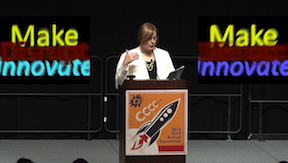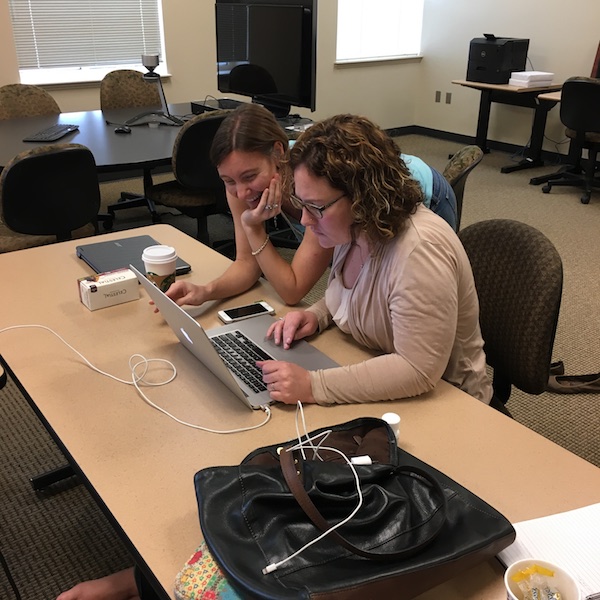
The final remediated video of "Making, Disrupting, Innovating"
Sarah & Erica
This remediation of the Conference on College Composition and Communication (CCCC) Chair's Address was an effort to enact Joyce's call (in the address itself) for the field of rhetoric and composition to reconceptualize the work we do in ways that make, disrupt, and innovate traditional notions of rhetoric, composition, and pedagogy. Thus, the goal for this project was to effectively remediate the address into a video in ways that would both convey Joyce's argument clearly and exemplify Joyce's call to disrupt and innovate.
We started by considering which software and hardware we would use. We wanted a program that we could install on our laptops so we would not be limited to working solely on computers in the Media Lab on campus. Knowing we would do a ton of work at all hours, including on Memorial Day weekend, we wanted flexibility in our working space. Starbucks, which was near the hotel where we were staying, was high on the priority list, as was the privacy of our own hotel rooms. Because Erica has a BFA in studio art and had used Final Cut Pro for film editing in the past, we decided to use a trial version of Adobe Premiere Pro because its features and interface seemed similar to Final Cut Pro.
Our rationale was that if we liked the program and were able to use it effectively, we could always buy the subscription later, and if it didn’t work the way we hoped, we hadn’t lost anything but time. The decision was a fairly simple one for us, one that we didn’t spend much time on, given that we wanted to work together in the program as often and as soon as possible. In particular, we were focused on finding software that we could use immediately and without too much of a learning curve, and that would allow us to move around campus, instead of being tethered to the computers in Texas Tech's English Department Media Lab.
We had also considered GarageBand, Audacity, and Audition for audio editing and agreed that we preferred the interface of Audition since, as Erica commented during one of our initial conversations, "The Audacity interface is so 1990s." Though both GarageBand and Audacity are free and Audition requires a subscription to Adobe Creative Cloud after the trial has expired, we felt that the interface of Audition was more familiar and user-friendly than Audacity. The ability to cut and modify sounds in Audition and then move them to Premiere Pro, where we could view the audio and the video together, made cutting and splicing easier and increased our productivity, a major concern given that we would only be in Lubbock for two weeks (making it also preferable over GarageBand).
Once we established the software we would use, we talked hardware. Erica's MacBook Pro was a faster and better overall computer choice than Sarah's PC laptop since it had more RAM, and it was preferable over the Media Lab's computers for the sole reason that it was portable and would not confine us to one space. (That particular choice backfired later, when we were unable—after multiple attempts—to get the video to export on her Mac, but it seemed like a good one at the time. See our discussion of technical issues.)
After making our tech decisions, we discussed, in detail, what we wanted our disruption of the address to look like. Initially, we had grandiose discussions imagining alternating images of tweets, clipart, the stage in Houston, logos of Texas Tech Technical Communication and Rhetoric program alums' business ventures, and stills of the audience cutting through Joyce's words and image. We considered the harsh sounds of punk music, soundbites, and commentary intermingling with her carefully planned speech; the possibility for making, innovating, and disrupting seemed endless. Then, true to our personalities, and aligned with specific rhetorical choices, our visions began to diverge.
Sarah was envisioning a serious disruption of the speech, with clips of Michael's interview of Joyce at Funky Door (parts of which can be heard in our discussion of context) interspersed with the actual address, pictures, and random sound bites, podcast-style. The more innovative, creative, and disruptive, the better, since this was not rhetorically what the CCCC audience would expect of a Chair's Address video. Thus, it would create the kind of constructed, innovative disruption that Joyce called for during the talk. Sarah imagined the video as a punk rock music video: the music drowning out the words in strategic places; images and examples of products and trends popping into view as Joyce mentioned them, completely obscuring the viewer's field of vision in those moments; and outside video clips and sound clips fading into and out of the speech itself as Joyce shifted topics, keeping the audience perpetually off-balance.
Erica had different ideas. As we discussed our vision for this video, she kept coming back to the fact that this video would represent CCCC and Joyce in her official role as chair: It needed to maintain some of the expected rhetorical structure that the genre of a Chair's Address evokes. For her, the video needed to more closely imitate the original address in order to maintain the ethos that CCCC audiences would expect. Our final version was a hybrid of both our views. Taking into consideration Joyce's request to give viewers an idea of the "flavor" of her talk, we created a video that was innovative enough to uphold Joyce's call to action (make, disrupt, innovate), but traditional enough to serve as documentation of the event itself:
Erica: We were talking about audience. So the people that come to watch this on YouTube, if they were there, they know what they're looking for. If they weren't there, they're looking for the message. So we tried really hard to make sure we weren't losing your words.
Joyce: So as long as a flavor of what it felt like to be there, I think that's a home run.
We had an extensive discussion about the genre expectations of the Chair's Address with Joyce. A live address has specific genre conventions that might be considered requirements: the typical thank-yous and acknowledgements of those who planned, facilitated, and supported the convention; nods to specific work that had been completed throughout the chair's tenure; mentions of award and scholarship recipients; a discussion of where the field has been and where it's going. All of these expectations constrain the genre of a Chair's Address. But when the chair is Joyce Locke Carter, and her address is titled "Making, Disrupting, Innovating," it's likely that the audience members expect some disruptions of the generic conventions of this address. How drastic those changes could be, given the genre conventions and the audience’s expectations, was a subject of much discussion between Joyce, Sarah, and Erica:
Joyce: So, and then, we're thinking, well, we could… well, this is a whole new thing. Yeah, it is a whole new thing. But you're right: It's a balance between what… if it's the Chair’s Address—I guess the Chair could give an address where you never see her face. You could stand behind a screen. You don't have to have—but it's kind of conventional, right?
Sarah and Erica: Hmmm.
Sarah: It is very conventional.
Joyce: In terms of genres, you want to find a way to say, This is the Chair's Address, and there's a Chair actually giving these words. And fixing the last two or three minutes. But it was still the Chair giving… And then there's this sense of—other—there's exhibits like PowerPoint stuff, and there's visualizations that were happening during the thing. So what we've done is put that together.

In between our conversations with one another and with Joyce, as well as our class meeting time, the May Seminar's schedule of events, and reading for class, we were also undergoing trial-by-fire learning Premiere Pro and Audition. Learning new software is always a challenge, but doing it in a pressure cooker of a two-week May Seminar made it sort of like going scuba diving without any lessons. Thus, we spent some of our time commiserating, laughing uncontrollably, and finally, panicking.
After many hours of intense work, where we sat together watching and rewatching footage of Joyce's address, discussing in detail how to manipulate the sound and the video (often both) to make it match our visions of what innovation and disruption look like, we began to realize that doing such a time-intensive process as a pair meant we'd never finish by the end of May Seminar. This led us to discuss how to speed things up and be both more efficient and more effective at editing for innovations and disruptions:
[the conversational din of Starbucks is in the background]
Erica: So I got a question for you.
Sarah: Hmhm.
Erica: If we continue at this pace…
Sarah: Yeah, we're never going to get…
Erica: So what if we just start doing shit? Is that dangerous? That's too dangerous.
Sarah: I don’t know. [Turns back to the Premiere Pro project.] Where's the flip over part? There it is. Let's do cube spin. Right here. I'm going to make it bigger.
Erica: I just think it's too grand. Like, I mean…
Sarah: Yeah, I know. It's exhausting.
Erica: It's exhausting, but it's so important.
Sarah: I know.
Erica: I just—I don’t—I mean, part of me is like, let's just split it up and start doing shit to it. But at the same time, it's like, oh…
Together, we worked to create a plan for how we would tackle the project at May Seminar and the months after, dividing responsibilities and working out which one of us would purchase the software we needed. Once we had a tentative plan in place, we encountered tensions between the message and the disruption; we wanted to be sure that Joyce's message remained intact, but we also tried to make sure the video replicated the type of visual disruption present during the actual address. From there, we worked to revise the remediation, making sure our conceptualized ideas matched our technical abilities. Lastly, we tackled several technological issues to ensure that we produced a cohesive remediation of the address.